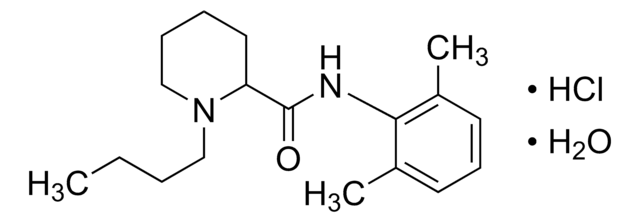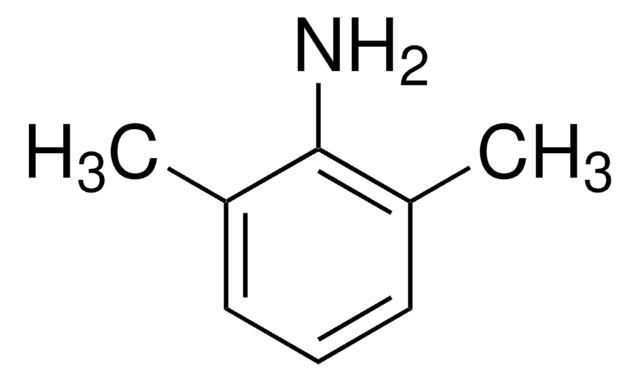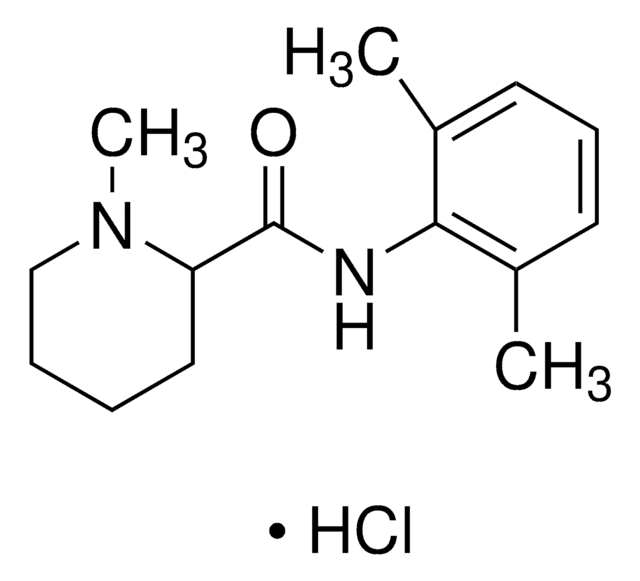おすすめの製品
グレード
pharmaceutical primary standard
APIファミリー
bupivacaine
メーカー/製品名
EDQM
アプリケーション
pharmaceutical (small molecule)
フォーマット
neat
保管温度
2-8°C
InChI
1S/C18H28N2O.ClH/c1-4-5-12-20-13-7-6-11-16(20)18(21)19-17-14(2)9-8-10-15(17)3;/h8-10,16H,4-7,11-13H2,1-3H3,(H,19,21);1H
InChI Key
SIEYLFHKZGLBNX-UHFFFAOYSA-N
関連するカテゴリー
詳細
この製品は薬局方標準品です。発行元の薬局方により製造・供給されています。MSDSを含む製品情報などの詳しい情報は、発行元の薬局方のウェブサイトよりご確認ください。
アプリケーション
Bupivacaine hydrochloride EP Reference standard, intended for use in laboratory tests only as specifically prescribed in the European Pharmacopoeia.
包装
この製品は発行元の薬局方による供給としてお届けします。現在の単位量については、EDQM reference substance catalogueをご覧ください。
その他情報
Sales restrictions may apply.
関連製品
製品番号
詳細
価格
シグナルワード
Danger
危険有害性情報
危険有害性の分類
Acute Tox. 1 Inhalation - Acute Tox. 2 Dermal - Acute Tox. 2 Oral
保管分類コード
6.1A - Combustible, acute toxic Cat. 1 and 2 / very toxic hazardous materials
WGK
WGK 3
引火点(°F)
Not applicable
引火点(℃)
Not applicable
最新バージョンのいずれかを選択してください:
この製品を見ている人はこちらもチェック
David R Walega et al.
Journal of oral & facial pain and headache, 28(2), 171-175 (2014-05-14)
Burning Mouth Syndrome (BMS) is a chronic painful disorder characterized by unremitting bilateral burning oral pain often associated with taste abnormalities and complaints of dry mouth. The diagnosis is made by history and symptom presentation in the absence of an
David Buck et al.
Anesthesia and analgesia, 119(1), 137-140 (2014-06-20)
An otherwise healthy 11-month-old, 8-kg infant presented for an elective circumcision. After a penile block with an excessive dose of 0.5% bupivacaine, the patient progressed to ventricular tachycardia. He was resuscitated with intralipid and had an uneventful recovery. The case
Michael J Beebe et al.
Clinical orthopaedics and related research, 472(5), 1394-1399 (2013-07-17)
Continuous femoral nerve block has been shown to decrease opioid use, improve postoperative pain scores, and decrease length of stay. However, several studies have raised the concern that continuous femoral nerve block may delay patient ambulation and increase the risk
Mingquan Chen et al.
Anesthesia and analgesia, 118(4), 863-868 (2014-03-22)
In this study, we sought to determine the median effective dose (ED50) for motor block of intrathecally administered plain bupivacaine in adults (20-80 years) and to assess the effect of age on ED50 required for motor block. This study was
Michael R Fettiplace et al.
Anesthesiology, 120(4), 915-925 (2014-02-06)
Recent publications have questioned the validity of the "lipid sink" theory of lipid resuscitation while others have identified sink-independent effects and posed alternative mechanisms such as hemodilution. To address these issues, the authors tested the dose-dependent response to intravenous lipid
ライフサイエンス、有機合成、材料科学、クロマトグラフィー、分析など、あらゆる分野の研究に経験のあるメンバーがおります。.
製品に関するお問い合わせはこちら(テクニカルサービス)






